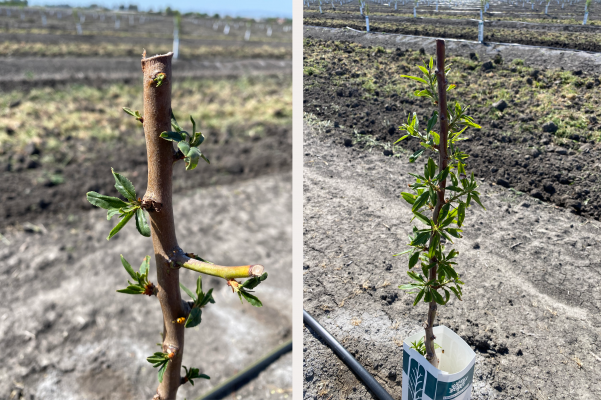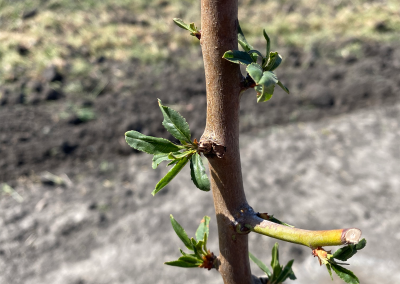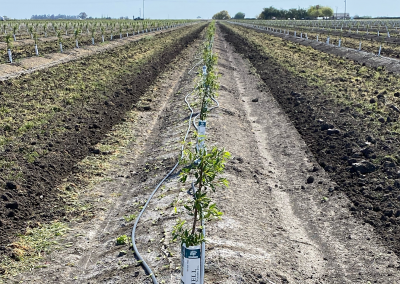
Here’s what the scene lookED like:
Symptoms:
- Stunted trees, about 1/3 the vegetative growth and leaf size of healthier-looking trees from same planting
- Affected trees located exclusively on south half of block
- Nearly all trees in the south half of the block are affected
- Single row between the two halves was affect only on south side
- Reduced root growth/activity also observed in stunted trees
Field Info:
- 4 month-old almond trees, Shasta, conventional, Root Pak 4 (rootstock)
- Merced County, CA
- 40 acre block (~20 acres affected)
- Stage of growth at time of symptoms: leaf out
- Irrigation type: above-ground dual line drip
- Water source: district
- Inconsistent water amendment program including gypsum and acid
- Soil texture: heavy clay, regularly has surface cracking
- Row orientation: East-west planting with no dividing roads
Notable Events:
Mid-Jan: Contact weed control spray applied
- Grower noted that the spray tank used for this application had not been fully washed out and may have contained residual material from a previous pre-emergent weed control application which was not intended for the current use.
- Two tank loads of herbicide spray were applied. Other than the possible residual material from the previous application in the first load, the loads were identical.
- The first load was applied to the south (affected) half of the field.
Mid-April: Symptoms assessed
- Grower contacted his crop advisor with concerns about the stunted trees
- Visual observations confirmed both above- and below-ground symptoms
Here’s what we know about WEED CONTROL AND PLANT GROWTH
- Weed control: Since weed control is a regulated area of farming, and it’s not our expertise, it’s best for us to not weigh in here. A side note, though, is that tank wash-out can be a big deal when it comes to fertilizers, and sometimes just a small amount of residual material can cause unexpectedly big problems. If the same is true for herbicides, this may have been one of those “perfect storm” situations.
- Plant growth: Young plants are particularly susceptible to their environment and slight changes in it. Mature trees have the resources to “brush off” many negative conditions that young trees do not. For this reason, farming practices are carefully calculated for new plantings so as not to impair growth in young trees.
Where it stands:
The grower, advising CCA and PCA agree that the residual material in the spray tank likely caused the stunted trees. The two halves have otherwise been farmed identically. It seems unlikely that there was a problem was with the weed control program itself, since it appears to have been effective and unproblematic on the north half.
Currently, all involved are working on a solution to the situation.
We’ll dig deeper and let you know what we find!
***
Thank you Mark Veteto from Source to Source for letting us dig deeper with you on this case!










